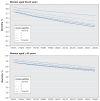Income-related differences in mortality among people with diabetes mellitus
- PMID: 20026629
- PMCID: PMC2802626
- DOI: 10.1503/cmaj.090495
Income-related differences in mortality among people with diabetes mellitus
Abstract
Background: Mortality has declined substantially among people with diabetes mellitus over the last decade. Whether all income groups have benefited equally, however, is unclear. We examined the impact of income on mortality trends among people with diabetes.
Methods: In this population-based, retrospective cohort study, we compared changes in mortality from Apr. 1, 1994, to Mar. 31, 2005, by neighbourhood income strata among people with diabetes aged 30 years or more in the province of Ontario, Canada.
Results: Overall, the annual age- and sex-adjusted mortality declined, from 4.05% in 1994/95 (95% confidence interval [CI] 3.98%-4.11%) to 2.69% in 2005/06 (95% CI 2.66%-2.73%). The decrease was significantly greater in the highest income group (by 36%) than in the lowest income group (by 31%; p < 0.001). This trend was most pronounced in the younger group (age 30-64 years): the mortality rate ratio widened by more than 40% between the lowest and highest income groups, from 1.12 to 1.59 among women and from 1.14 to 1.60 among men. Income had a much smaller effect on mortality trends in the older group, whose drug costs are subsidized: the income-related difference rose by only 0.9% over the study period.
Interpretation: Mortality declined overall among people with diabetes from 1994 to 2005; however, the decrease was substantially greater in the highest income group than in the lowest, particularly among those aged 30-64 years. These findings illustrate the increasing impact of income on the health of people with diabetes even in a publicly funded health care setting. Further studies are needed to explore factors responsible for these income-related differences in mortality.
Figures



Similar articles
-
Trends in diabetes prevalence, incidence, and mortality in Ontario, Canada 1995-2005: a population-based study.Lancet. 2007 Mar 3;369(9563):750-756. doi: 10.1016/S0140-6736(07)60361-4. Lancet. 2007. PMID: 17336651
-
Diabetes prevalence, incidence and mortality in First Nations and other people in Ontario, 1995-2014: a population-based study using linked administrative data.CMAJ. 2020 Feb 10;192(6):E128-E135. doi: 10.1503/cmaj.190836. CMAJ. 2020. PMID: 32041696 Free PMC article.
-
Age- and sex-related prevalence of diabetes mellitus among immigrants to Ontario, Canada.CMAJ. 2010 May 18;182(8):781-9. doi: 10.1503/cmaj.091551. Epub 2010 Apr 19. CMAJ. 2010. PMID: 20403889 Free PMC article.
-
The impact of income on the incidence of diabetes: a population-based study.Diabetes Res Clin Pract. 2013 Mar;99(3):372-9. doi: 10.1016/j.diabres.2012.12.005. Epub 2013 Jan 8. Diabetes Res Clin Pract. 2013. PMID: 23305902
-
Trends in socioeconomic status-related differences in mortality among people with chronic obstructive pulmonary disease.Ann Am Thorac Soc. 2014 Oct;11(8):1195-202. doi: 10.1513/AnnalsATS.201403-094OC. Ann Am Thorac Soc. 2014. PMID: 25166428
Cited by
-
Growing social inequality in the prevalence of type 2 diabetes in Canada, 2004-2012.Can J Public Health. 2015 Mar 12;106(3):e132-9. doi: 10.17269/cjph.106.4769. Can J Public Health. 2015. PMID: 26125239 Free PMC article.
-
The social determinants of health for people with type 1 diabetes that progress to end-stage renal disease.Health Expect. 2015 Dec;18(6):2513-21. doi: 10.1111/hex.12220. Epub 2014 Jun 17. Health Expect. 2015. PMID: 24938493 Free PMC article.
-
Unveiling inequalities: Racial, ethnic, and socioeconomic disparities in diabetes: Findings from the 2007-2020 NHANES data among U.S. adults.Prev Med Rep. 2024 Dec 27;50:102957. doi: 10.1016/j.pmedr.2024.102957. eCollection 2025 Feb. Prev Med Rep. 2024. PMID: 40007950 Free PMC article.
-
A systematic review of trends in all-cause mortality among people with diabetes.Diabetologia. 2020 Sep;63(9):1718-1735. doi: 10.1007/s00125-020-05199-0. Epub 2020 Jul 6. Diabetologia. 2020. PMID: 32632526 Free PMC article.
-
Insulin Secretory Actions of Ethanol Extract of Eucalyptus citriodora Leaf, including Plasma DPP-IV and GLP-1 Levels in High-Fat-Fed Rats, as Well as Characterization of Biologically Effective Phytoconstituents.Metabolites. 2022 Aug 17;12(8):757. doi: 10.3390/metabo12080757. Metabolites. 2022. PMID: 36005629 Free PMC article.
References
-
- Lipscombe LL, Hux JE. Trends in diabetes prevalence, incidence, and mortality in Ontario, Canada 1995–2005: a population-based study. Lancet. 2007;369:750–6. - PubMed
-
- Wild S, Roglic G, Green A, et al. Global prevalence of diabetes: estimates for the year 2000 and projections for 2030. Diabetes Care. 2004;27:1047–53. - PubMed
-
- World Health Organization. Diabetes programme: facts and figures. Geneva (Switzerland): The Organization; 2008. [(accessed 2009 Oct. 20)]. Available: www.who.int/diabetes/facts/en/index.html.
-
- Booth GL, Kapral MK, Fung K, et al. Relation between age and cardiovascular disease in men and women with diabetes compared with non-diabetic people: a population-based retrospective cohort study. Lancet. 2006;368:29–36. - PubMed
-
- Gregg EW, Gu Q, Cheng YJ, et al. Mortality trends in men and women with diabetes, 1971 to 2000. Ann Intern Med. 2007;147:149–55. - PubMed
Publication types
MeSH terms
Grants and funding
LinkOut - more resources
Full Text Sources
Medical
Miscellaneous
